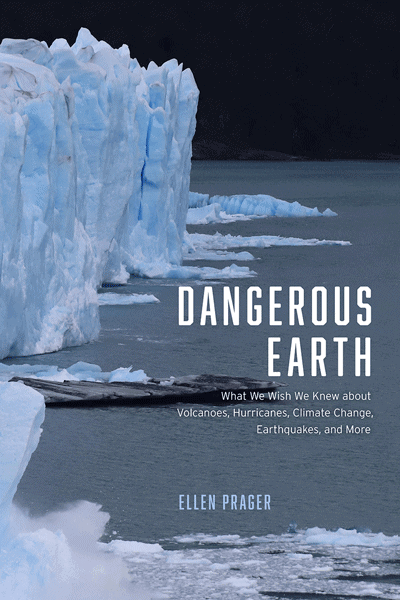Ellen Prager Dangerous Earth: What We Wish We Knew about Volcanoes, Hurricanes, Climate Change, Earthquakes, and More (University of Chicago Press, 2020), pp. 230 ISBN: 9780226541693 $25
The Earth is both a life-supporting planet and a violent one. What makes it liveable can also cause catastrophe. Volcanic eruptions create fertile nutrient-rich fields but can also bury towns. Water and wind spread life and, as hurricanes, leave devastation behind their passage. History supplies us with any number of accounts of such natural disasters. But of particular concern to us today is the earth’s rising temperature – our planet’s warmth is life-enabling but its increasing temperature in recent decades has caused sea-levels to rise and extreme weather events to become ever more extreme.
The author, a marine scientist formerly at the University of Miami’s School of Marine and Atmospheric Sciences, has produced a comprehensive and compelling account of what scientists know about such forces and what they wish they knew. Four chapters each focus on a specific hazard: Volcanoes, Earthquakes and Tsunamis, Hurricanes, and a final chapter on such oceanic hazards as Rogue Waves…and Sharks. Concerned to fully set out what we know about such forces by detailing how – and when – we first knew what we know, she starts off each chapter with ‘a game-changing historical event,’ such as the eruption in 1980 of Mt St Helens. Her book is also abundantly illustrated throughout. One particularly striking example is a full-color photograph of the Earth’s curvature, taken from a spacecraft orbiting 320 kilometers in space, where our atmosphere appears as a thin blue band encircling our planet. The sense of its fragility is all too apparent.
Her first chapter, on Climate Change, sets the stage for all that follows: for starters, all our concerns over natural disasters culminate in the ominous consequences of climate change; and the chapter’s deft – systematic, if by necessity succinct – exposition of key facts and arguments is a model of expository coverage. We humans are short-lived creatures on the skin of our planet. The origins of the Earth’s dynamic and ephemeral processes are hidden from our view, in the oceans’ depths, below the polar ice, above the clouds. Our own historical record of events are but a blip in our planet’s billions of years of existence. Yet, scientists have developed sophisticated and rapidly improving technology. Data is critical to scientific prognosis (a basic fact hopefully brought particularly home to us by the current pandemic). The data on climate change, accumulated in recent decades, is alarming, indeed.
Our atmosphere is but 100 kilometers thick, wafer-thin in comparison to the size of the Earth. Yet, this thin layer of oxygen, nitrogen, and trace gases is what enables us to breathe and prevents our planet from plunging into the frigid cold of Mars. Our atmosphere is not an unknown like dark matter; it is very much a known known. Prager sets out a step-by-step explication of what the atmosphere does for us (and all life); of what the burning of fossil fuels does to the atmosphere; of how carbon dioxide concentration is measured (beginning in the 1950s with the work done by ocean scientists from the Scripps Institution of Oceanography); of how scientists have been able to reconstruct a record of global temperatures and carbon dioxide concentrations going back hundreds of millions of years, through the recovery of such indicators of ancient times as bubbles of air trapped within layers of ice or undisturbed layers of sediment in lakebeds or oceans.
We now know that the Earth’s average temperature has risen more than 1°C since 1880 and that there were similar periods of global climate change thousands and millions of years ago. The key is that it’s not the actual temperature that is of current concern; it’s the rapid pace at which our global thermometer is rising. The last several years have been the warmest ever recorded. If business is allowed to go on as usual, then by the end of this century the global temperature will rise another 2°C or more.
Prager spells out the consequences of this unchecked temperature rise with graphically detailed sections on sea-level rise, ice sheets, Antarctica and the Arctic, permafrost, the oceans’ flow, coral reefs, ocean dead zones, and extreme weather events. As we in California know only too well, such destructive events have become virtually daily news items: wildfires, record-setting temperatures, severe drought, storms. In 2017, there were sixteen such weather and climate disasters in the United States that cost at least a billion dollars each. Cumulative costs topped $300 billion. More recently, the Camp wildfire was one of the most costly and destructive in history, moving faster than people could flee and leaving an entire town as little more than charred remains.
The four chapters that follow, while, in length, necessarily but surveys, are equally comprehensive in coverage and each could well serve as a definitive introduction to its specific subject. I thought of terming this book a primer on natural disasters and, if that is taken to mean a thorough introduction for the ordinary reader on what goes on on our planet and why, then it is very much that. But ‘primer’ can sound dismissive. So let’s be clear. This short book is both a model of how to explain what our scientists have discovered about natural disasters and particularly climate change and how they have done so and an unequivocal caution for all of us to believe in their science.
Disclaimer: This site contains affiliate links to products. We may receive a commission for purchases made through these links. This does not impact our reviews and comparisons.

